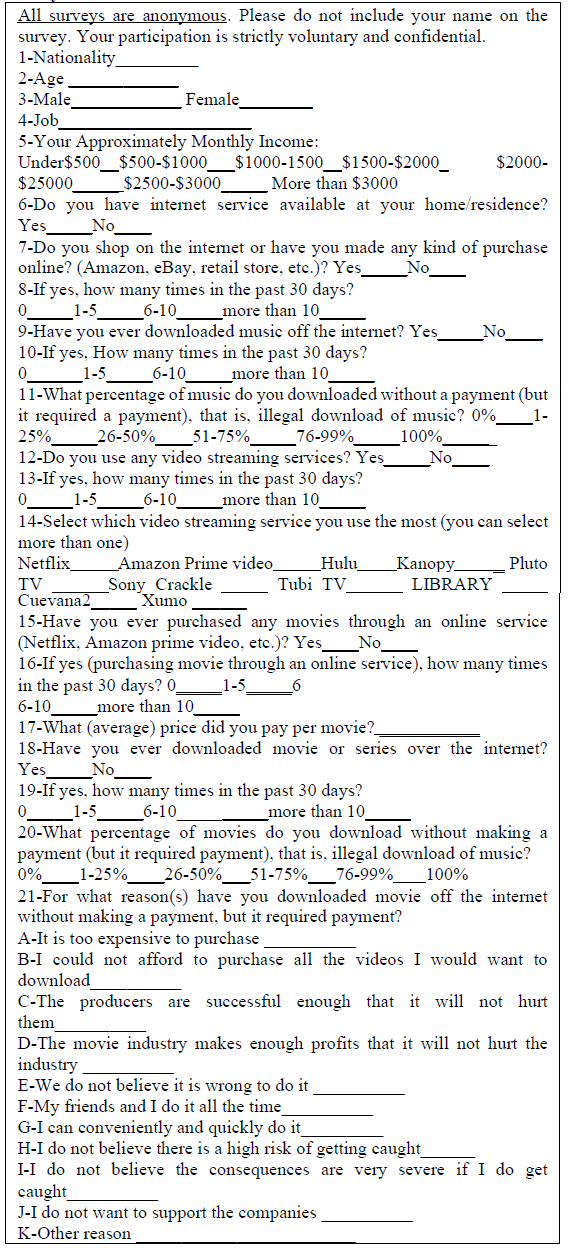1. Introduction
The usage of video streaming services has grown considerably all around the world in the latest years. A video streaming service is an on-demand online entertainment source for TV shows, movies, and other streaming media. Streaming services offer updated databases that allow users to access new movies and series. Netflix is currently the world’s leader in these services, this company was initially established in 1997 as an online DVD rental service and expanded into video streaming in 2010, and today has 148 million members. However, while there has been a substantial commercial advance of these services, video piracy is still occurring misbehavior within internet users [1].
Typically, video streaming services offered tiered prices concerning video quality and simultaneous watching; there is no limit on how much media the consumer can access, with new items being continuously added to their database. Video streaming services work by digitally ‘renting’ the media to the consumer, meaning that the user does not own the media and if they wish to watch it multiple times or want to keep it, then this might be a tempting reason to pirate the media in order to illegally own it. Additionally, video streaming requires a constant internet connection every time that the media is accessed, while if the media is illegally downloaded then it can be accessed every time after the initial download. This behavior can explain the user wanting to choose piracy over the price of streaming, especially if there are data charges involved. It is important to note that streaming is legal and poses no risks, while participating in piracy opens users up to multiple risks, such as viruses or legal actions against the user.
In general, both streaming and piracy have similar characteristics and allow consumers to watch their favorite movies. Additionally, the two alternatives have an extensive database; however, streaming provides an easy to access procedure that allows consumers to find their desired movies comfortably. Therefore, it is expected with the increased use of streaming services, the less illegal movie downloading. Contradictorily, it is also possible to argue that from the standpoint of a significant segment of consumers, it is believed that streaming would increase movie piracy. This belief is explained by using streaming as an efficient instrument to find out about new releases. This perception allows users to have an interchangeable behavior in regard to streaming or participating in piracy. For the more popular streaming services, their entry fee is quite affordable for most. Free alternatives to paid streaming services also exist, making the behavior of consumers towards piracy as opposed to streaming a relevant topic to be examined.
Recently, [2] studied the complementary features of music streaming and music piracy in USA students. Empirical results of these authors indicate that streamers have piracy behavior and details a group of reasons that would explain the illegal download. Considering these facts, is the same phenomenon possible in streaming video services? Is there any significant relation between movie streaming and movie piracy? This study is oriented to help answer these questions. In concrete, the objective of this study is to identify if movie streaming increases movie piracy. In order to meet the study objective, exploratory analysis is conducted in Chilean internet users based on the methodology proposed by [2]. Although this study is a methodological replication, the technology in which the study focuses as the sample characteristics give it elements of originality. Therefore, we believe that the findings of this study can serve as a basis for a more in-depth analysis of the subject in Latin America.
The rest of the paper is provided in five sections. Section two explains the theoretical framework and presents the study hypotheses. Section three describes the methodology used in the empirical study. Section four shows the result of the statistical analysis. Finally, section five provides a conclusion.
2. Literature review and hypotheses
Digital piracy among the younger population has been an appealing object of study for social scientists and economists [1-5]. Moreover, increasing the growth of digital services such as movies or music streaming gives consumers more options regarding illegal behaviors. Several antecedents have been associated with this behavior, and then we review a set of them.
2.1. Substitutes complement
Consumers’ awareness of comparable products and ability using digital products interchangeably, has been observed in the last years. These studies concentrated on how piracy behavior has changed from physical CDs to online movie and music piracy [2], [6-10]. Some articles have studied streaming and piracy behaviors. These studies have shown that consumers use streaming services as a powerful tool to find media that meets their interests and download it illegally later. [11] studied paid or unpaid movie consumption in two samples, 372 Chinese students and 3852 USA students. Their result showed that three-quarters of American students participated in unpaid consumption, while 14 percent of students who used unpaid services are using paid services. [1] demonstrated that music streaming enhances the chances of music piracy, in this same line, [2] implemented 1052 surveys among college students and provided evidence that music streamers are 11% more likely to pirate music than non-streamers. Considering the above, we propose the following hypothesis:
H1: Movie streaming affects the likelihood of engaging in the activity of movie piracy.
2.2. Peer pressure
The theory of planned behavior [12] helps to explain piracy behavior. Following [12], we can offer three viewpoints on behaviors. First, individual perceptions of risks and rewards and consequences of illegal behavior. Second, social perception of rewards and risks which influence upon behavior, amongst social groups. This cognition is observed regarding show braveness in social gatherings. Third, control of behavior or perception of controlling the acts which contain purposes and actions. Many researchers have used the theory of planned behavior in regards to software, music, and movie piracy[4,10,20,12-19]. Expenses and saving money are the fundamental reasons for misbehavior in software piracy [21-23]. It would be an honorable act in social relations in which consumers show their braveness by explaining their risky treatment.
The social learning theory supplements these results [24]. It proves that individuals are more likely to participate in illegal activity if they socialize with groups actively committing criminal behavior. The concept is that consumers within a criminal group are presented favorable attitudes towards the crime, and therefore replicate it as soon as possible. [25] proved that “I know lots of people who download more than I do” is strong enough to participate in illegal downloading. Also, [5,26] found that social learning variables are associated with digital piracy. [2] found that peer attitudes towards piracy increase the probability of piracy. Considering the above, we propose the following hypothesis:
H2: Peer pressure increases the likelihood of engaging in movie piracy.
2.3. Risks and fines
Most consumers know the fact that movie piracy has costs, such as jail time or fines. However, younger people have a different perception of the risk, where piracy is not as same as shoplifting or stealing [17]. [27] proposed a hypothesis regarding risk aversion in which the consumers who have risk aversion, interested in legal movie downloading websites. Nowadays, internet activities are proliferating, and the age of using the internet has been decreasing, meaning that young people should be aware of penalties and fines. For instance, [28] found that 90% of participants of their survey declared illegally downloading acceptable behavior.
College students perceived moderate risk associated with illegal downloading of music, [29] found that student respondents did not believe in jail or any punishment due to illegal behavior. Moreover, other researchers found similar results considering the perception of risks and penalties [17,29-35]. Based on this literature, we propose the following hypothesis:
H3: Low perception of the risks and penalties associated with movie piracy increases the likelihood of engaging in movie piracy.
2.4. Perceptions about the movie industry
People have not seen punishment for pirates as same as street criminals [36]. Therefore, an ordinary perception exists among young consumers that piracy does not bother the movie industry because the movie industry is a billion-dollar business; therefore, downloading a movie will not hurt the studios [37]. These reasons are seemed enough for pirates to download their movies illegally. Based on these ideas, we propose the following hypothesis:
H4: Consumers’ view of the movie industry affects the likelihood of engaging in movie piracy.
2.5. Online activity
According to the theory of planned behavior [12] an antecedent to act is behavioral control, which refers to controlling the procedure to be performed. [2] found that online activities influence in piracy behavior. Similarly, [38-39] studied how internet skill impacts piracy by measuring hours that consumers spend daily and they found that more hours spent meant more piracy behaviors. Besides, [24,36] used similar tools to measure the knowledge of consumers. According to these studies, we propose the following hypothesis:
H5: Online activities increase the likelihood of engaging in movie piracy.
2.6. Demographics
Demographic variables such as age, gender, profession, and monthly income can explain movie piracy from different points of view. For instance, the more income, the less piracy [31]. However, gender has had different results. Some researches illustrated that males are more likely to participate in piracy [2,21,37,39,40], but others have not found similar results [1,17]. Considering these ideas, we propose to explore the following hypothesis:
H6: Demographics variable, such as age, gender, profession, and monthly income, affect the likelihood of engaging in movie piracy.
3. Materials and methods
3.1. Sample
An online survey in Spanish was implemented in Chile and 145 responses were collected. In summary, downloading movies illegally was reported by 35% of participants, and the average sample age was 24 years old. For analysis, the sample was divided into two groups: students and not students.
3.2. Measure instrument
The questionnaire includes 21 questions, containing measures of demographic variables, for instance, age, gender, profession, and monthly income. Eight questions were conducted according to online activities, such as downloading movies and music, shopping, music, and movie streaming. Illegal downloading of music and movies was requested by four questions, which were designed by a set of 10 independent variables to be selected as personal treatments. Appendix A shows the survey instrument.
3.3. Statistical technique
Logit models have been applied to evaluate the influence of movie streaming services on the likelihood of piracy behavior. Moreover, consumers’ cognitions have been examined in terms of risks associated with piracy, views about the industry and the peer pressure impact as which are affecting the likelihood of illegal downloading of movies. The general model is described in Eq.(1).
The dependent variable Z is the dichotomy index that takes a value of 1 if subject i reported illicit downloading of movie and 0 otherwise. P is the probability or likelihood that Zi equals 1. X represents the explanatory factors, including Streaming, which takes a value of 1 if any movie streaming service was used in the past 30 days and otherwise 0. D is a vector of demographic variables, and Hj, i represents factor j from the list of 10 explanatory statements for piracy. For example, if the respondent i marked item H1, then H1, i takes a value of 1 (see Appendix B for details on the rest of statements or arguments.).
4. Results
Table 1 shows summary statistics and comparative values between those who stated they had engaged in a recent activity of illegal downloading a movie (Group 1) and those who did not (Group 2) by two-sample T-test. The average ages of groups 1 and 2 are 24 and 27 years old, respectively, and this difference in age is statistically irrelevant (SD=0.09, p- it is not significant enough to be accepted in the test (SD=0.071, p-value=0.077). Table 1 provides preliminary evidence of the complementarity feature between movie streaming and piracy. The results from the logit models are represented in terms of likelihood to participate in movie piracy. We post-estimate the odds ratio that a student participates in illegally downloading movies to facilitate the interpretation of the results. The odds ratio measures the strength of association between two events (A and B) if the results of the odds ratio are one (A/B = 1), this shows that both events are independent of each other. Results higher than one (A/B >1) indicate that both events are positively correlated. The odds result of the odds ratio being less than one (A/B < 1) indicates a negative correlation between events.
Table 1 Descriptive statistics by type of individual.
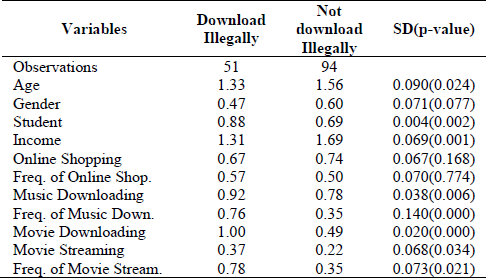
Note: Values are means of the sample.
Source: The Authors.
Tables 2 and 3 show the main results from Eq. 1. For each model. From the results we can see that profession plays a role in the likeliness to participate in the behavior as it has a significant p-value for all models at the p < 0.05 level, which indicates those students are more likely to pirate movies than non-students.
Table 2 The probability of illegal downloading of movie (I).
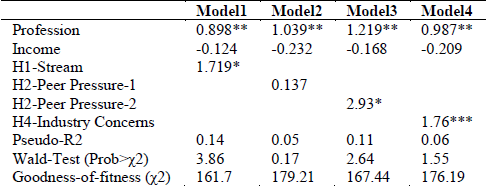
Note: *, **, and *** indicate statistical significance at 1%, 5%, and 10%, respectively. The Wald-Test verifies that all estimated coefficients are statistically significant predictors. The goodness-of-fitness test indicates that the Logit model fits the data reasonably well.
Source: The Authors.
Table 3 The probability of illegal downloading of movie (II).
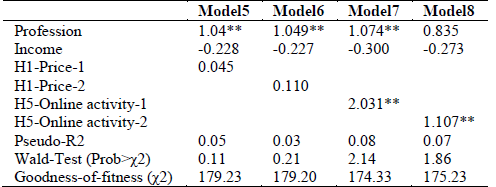
Note: *, **, and *** indicate statistical significance at 1%, 5%, and 10%, respectively. The Wald-Test verifies that all estimated coefficients are statistically significant predictors. The goodness-of-fitness test indicates that the Logit model fits the data reasonably well.
Source: The Authors.
Model 1 in Table 2 indicates that streaming habits have a positive correlation between streaming and partaking in movie piracy, with the odds ratio showing that streamers are 5.58 times more likely to participate in piracy than non-streamers. We can also see that this factor has a p-factor that proves that the factor is significant at the 1% level. Overall, this model has a goodness of fit of 0.112, which by being higher than 0.05, indicates that this model fits the data quite well. From model 3 we can that the peer pressure factor of “My friends and I do it all the time” makes the person almost 18.7 times more likely to participate in this behavior, on the other hand, the other pressure factor (“We do not believe it is wrong to do it”) only increases the odds of this behavior by 1.15 times. We can also see that this peer pressure factor for model 3 is significant at the p < 0.1 level and the overall model has a significant p-value for the goodness of fit (0.064), this is not the case for model 2, meaning that model 3 fits the data well, while model 2 does not. Model 4 indicates that by not having concerns about the effect of piracy on the movie industry is a significant factor in the choice of participating in this behavior and increases the odds of participating by 5.8 times. This model proves that the factor is significant at the p < 0.01 level; however, since the p-value of the goodness of fit is 0.024, this model is not a good fit for the data. In Table 3, models 7 and 8 show that at higher levels of online activity, the more likely the user is to participate in the behavior, which more online activity pointing to higher odds in participating in movie piracy.
Of these models, both factors are significant at the p < 0.5 level; however, the goodness of fit test indicates that neither model is a good fit for the data. Taking the streaming factor from Model 1 into consideration, Table 4 shows the regression models for all hypotheses when considering streaming as a factor. From these results, we can see that from the demographic factors profession is a predicting factor, as also seen in Tables 2 and 3.
Table 4 The probability of illegal downloading of movie with stream.
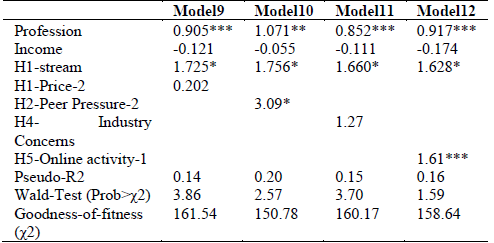
Note: *, **, and *** indicate statistical significance at 1%, 5%, and 10%, respectively. The Wald-Test verifies that all estimated coefficients are statistically significant predictors. The goodness-of-fitness test indicates that the Logit model fits the data reasonably well.
Source: The Authors.
Regarding the hypotheses, we can reject H2, the effect of price on the behavior, and H4, the effect of concerns for the industry as a predicting behavior. We can reject these since they did not provide statistically significant results in order to validate their effect on a prediction model. From model 10, we can see that H3, peer pressure, is a significant factor in predicting the behavior (p<0.01) and the presence of this peer pressure makes the person 21.9 times more likely to participate in piracy, which is much higher odds ratio than H5. Online activity, which is also statistically significant (p<0.1) albeit not to the same level, and increases the odds of piracy behavior by 4.990. We can also see that from both these models, H3 has a much higher level of goodness of fit than the alternative, meaning that this model can account for the piracy behavior better than the other models obtained.
5. Conclusion
This study aims to identify if movie streaming increases movie piracy. For this purpose, we implemented a survey with 145 respondents to make a methodological replication of [2] study; Since we expected some differences because of distinct people and different tastes, most of our results are consistent with their study findings. The main point is that the core idea was preserved: Movie streamers intentions to engage in downloading movies illegally. However, there is a more significant and valuable conclusion that displays the effect of peer pressure as a determining behavior among Chilean students.
Finally, there are two opinions from the study results. First, movie piracy and streaming influence each other interchangeably. This fact implies that emphasis should be placed on educational policies that explain the damage of piracy and how it should be combated. Second, this study supports the idea that the main reasons for digital piracy are based on social behavior. We believe that this line of work should be deepened, with an analysis of the social networks of both the consumer and the pirate user.














